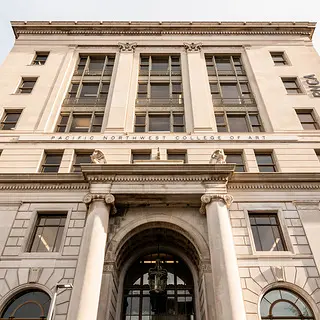
A Post Office-Turned-Art School in Portland, Oregon
This past December, Preservation magazine Managing Editor Meghan Drueding attended an event at the Pacific Northwest College of Art in Portland, Oregon. She was so impressed with the school's adaptive reuse of a historic post office building that we decided to re-publish and update Cheryl Weber's print-only magazine story from our Spring 2015 issue here.
The venerable 511 Federal Building in Portland, Oregon, has started its third act. Designed in 1916 by Lewis Parsons Hobart as a grand central post office, the 134,000-square-foot building reopened early in 2015 as the Arlene and Harold Schnitzer Center for Art and Design at the Pacific Northwest College of Art (PNCA).

photo by: Mario Gallucci
The historic Ann Payne Edlen Creative Corridor, with new mezzanine levels in the background.
Architect Brad Cloepfil of Allied Works Architects preserved key historic features that had been covered up after the post office moved out, including an enormous atrium, 39 arched first-floor windows, and a grand corridor with marble-lined walls and Neoclassical ceiling flourishes.
Federal government offices had occupied the building since the 1960s, and parts of it were shrouded in secrecy, says Gus Baum, senior director of planning and innovation at PNCA. “Large HVAC ductwork systems covered all the sawtooth transom windows, and dark rooms were built into the middle of light-filled spaces,” he says.

photo by: Mario Gallucci
A restored ceiling detail from the original building.
Constructed on the heels of the 1906 San Francisco earthquake, the 511 is one of Portland's first steel-frame buildings. The $33 million PNCA project restored the limestone exterior and the grand hall, which now opens to an airy main atrium and performance court. It also added 9,000 square feet on mezzanine levels and incorporated spaces for art exhibits and public lectures, plus classrooms, production facilities, and a library.
“You can see that the Italian Renaissance building was designed when electricity was expensive, so the building is full of natural light,” Baum says. “It’s perfect for an art college.”


